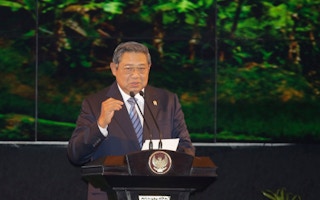The president of Indonesia Susilo Bambang Yudhoyono on Monday called on his successor to continue a moratorium to protect the country’s forests and urged regional governments, businesses and international forestry organisations to embrace initiatives to promote sustainable forestry.
To continue reading, subscribe to Eco‑Business.
There's something for everyone. We offer a range of subscription plans.
- Access our stories and receive our Insights Weekly newsletter with the free EB Member plan.
- Unlock unlimited access to our content and archive with EB Circle.
- Publish your content with EB Premium.
Speaking at the Forests Asia Summit in Jakarta, President Yudhoyono asked for his successor to extend the moratorium on clearing forests and peat swamps for plantations and other agricultural purposes in Indonesia, which he has already extended until 2015. The policy aimed to protect more than 63 million hectares of primary forests and peatlands, an area he compared to be larger than the combined land mass of Malaysia and the Philippines.
He also urged Southeast Asian governments to highlight the critical significance of sustainable forestry in the upcoming climate policy negotiations, as well as for the Asean countries to increase its focus on climate change adaptation and the promotion of low-carbon economy.
“Many hope that the post-Kyoto [Protocol] process will recognise the true value and contribution of forest landscapes—their economic, social and environmental values. In this regard, Indonesia and other Asian countries must ensure that the upcoming climate negotiations in Lima, Peru, give particular attention to this matter,” Yudhoyono said in his keynote speech.
Indonesia possesses the world’s second longest stretch of mangrove forests and the largest area for tropical peatlands that could capture significant amounts of carbon, said the outgoing president. He stressed: “Keeping them intact is essential for averting the worst impact of climate change.”
Peatlands are wetland areas made up of layers of soil and decaying plant materials, which according to experts, have the capacity to store at least 550 gigatonnes of carbon. Peatlands include moors and swamp forests.
Mangrove forests, on the other hand, has been known to protect coastal areas from erosion and inland areas from high waves and floods, a risk that continues to threaten Indonesia and other Southeast Asian nations.
The president who has become known for his ‘green legacy’ since introducing the landmark forest moratorium in 2011, stressed however that “Indonesia cannot do it alone.”
“
Many hope that the post-Kyoto process will recognise the true value and contribution of forest landscapes—their economic, social and environmental values. In this regard, Indonesia and other Asian countries must ensure that the upcoming climate negotiations in Lima, Peru, give particular attention to this matter
Susilo Bambang Yudhoyono, president of Indonesia
Indonesia’s leadership
While Indonesia’s deforestation is a major source of greenhouse gas emissions in his country, he said its commitment to fight these illegal activities is a significant contribution to the global efforts in mitigating climate change.
However, the achievements of his administration to lower deforestation rate through the suspension policy continues to be overshadowed by forest fires that hit Riau province in eastern Sumatra.
Researcher David Gaveau of the Centre for International Forestry Research, the non-profit group that organised the two-day event, said in one of the sessions that 84 per cent of the Sumatran forest fires occurred in peatlands, out of the 163,336 hectares that went burning last year.
The president himself admitted that the case of Riau is a man-made disaster that teaches an important lesson and pointed out the need for a strengthened forestry governance, including for the recently established REDD+ agency. He also recommended that an accurate forests mapping for conservation and sustainable land use will help settle claimants’ land issues.
However, for environmental campaign group Greenpeace, all these efforts may only go up ‘in smoke’ unless there is a stronger law that protects all peatlands and forests, it said in a statement on Monday, following the president’s remarks.
Bustar Maitar, head of the Indonesia forest campaign at Greenpeace International commented that the president should push for amendments of the country’s peat regulations. The Peat Regulation has not delivered a more articulate ruling over the protection and management of all peatlands against fires, he said.
Decades of forest destruction to make way for industrial scale plantations has left vast areas of moist peatlands bare, drained and prone to fires, Bustar explained, adding that protecting them and Sumatra’s forests is the region’s first defence against the forest fire crisis.
He noted: “Greenpeace’s supporters in Indonesia and worldwide have pushed big corporations like P&G to commit to forest protection – he [the president] now has the momentum to turn this progress for forest protection into a tangible transition to a ‘green’ economy.”
Meanwhile, Singapore’s environment and water resources minister Vivian Balakrishnan, who also spoke at the event as one of the plenary speakers, called for quick action on the transboundary haze bill, a legislation that will penalise companies causing transboundary pollution brought by burning and clearing of lands.
Balakrishnan pressed on the need for regional governments to take a more determined stand against irresponsible companies caught destroying the environment. However, he said on the sidelines of the event that the bill will have to wait a little longer and will be tabled in the Parliament by the second half of this year. It will go through another round of consultation, he noted.










